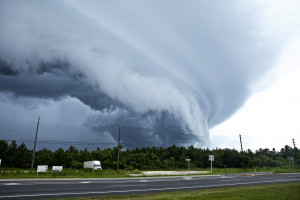 On May 22, 2008, the small, northern Colorado town of Windsor was devastated by a mile-wide, EF3-rated tornado that killed one person and injured more than a dozen more with winds reaching 150 mph.
On May 22, 2008, the small, northern Colorado town of Windsor was devastated by a mile-wide, EF3-rated tornado that killed one person and injured more than a dozen more with winds reaching 150 mph.
More than 60,000 people were left without power, and some 1,000 of them were forced to seek shelter in the local high school after their homes were damaged. Then-Colorado governor Bill Ritter declared a state of emergency in the area.
The tornado—the third fatal storm in Colorado history—caused $193.5 million in damage from about 24,000 auto and homeowner claims, and the U. S. Small Business Administration ended up approving more than $3 million in disaster loans to individuals and businesses in Weld County who had suffered damage from the storm.
Think this is a one-time occurrence?
Tornado season in Colorado, as well as the rest of the country, typically stretches from mid-May to mid-July, with June being the most active month with two-thirds of all tornadoes occurring then. Colorado as a whole averages about 60 tornadoes per year, more than a few of which occur on the Front Range.
Tornado risk across Colorado
Although the famed “Tornado Alley” that stretches across the U.S. Midwest from Texas to Minnesota—the region that sees the most tornado activity on average—gets most of the attention, Colorado is hit by its fair share of tornadoes every year too. In fact, the state ranks ninth in the country for number of tornadoes, according to the National Weather Service.
Although most of these storms touch down on Colorado’s Eastern Plains, the Front Range is not immune from tornado activity, as the 2010 Windsor tornado proves. Even the city of Denver has seen tornado strikes, with a cluster of storms touching down in the metro area in 1988, causing extensive damage, followed by an F-1 rated tornado in June 1993. These storms are typically not as strong as their Midwestern counterparts—F-0 to F-1 rated storms are most common for the area—but the risk of injury, property damage and even death are very real even with these diminished tornadoes.
According to insurance company Lloyd’s of London, the U.S. experiences more tornadoes than any other country, and these storms accounted for 39% of all insured catastrophe losses from 1995 to 2014. Nationally, there were $12.3 billion worth of from tornadoes in 2014, up from $10.3 billion in 2013.
Protecting your home
What can homeowners and businesses do to protect their property in the case of a tornado?
Doors
According to the Federal Emergency Management Agency, storm-resistant doors are those that can withstand the impact of a 12-foot-long 2 x 4 flying like a missile at 100 mph. These types of doors exist, and should be considered as an upgrade for entry doors in tornado.
Beyond that kind of heavy hardware, make sure that all external entry doors are secured with two-inch deadbolts and hung with three hinges that are well screwed into the wall framing. And the door frame itself should be well anchored, using something longer and stronger than standard framing nails—a solid steel door won’t do anything to protect you if the frame itself can be torn out of the wall.
Further, garage doors represent the largest potential opening in many homes and should be braced with wood or metal stiffeners to withstand high winds. Most garage doors today are designed to withstand 50 pounds of pressure per square foot or more, but vertical bracing systems are available to anchor the door into the walls and floor, preventing the door from blowing in or suctioning out.
Windows
After the doors, a home’s windows present the next-most-likely path of entrance into a structure in a windstorm or tornado, with the added bonus of broken glass that can turn into a deadly projectile on its own.
The best protection in this scenario is to install impact-resistant windows, which are required by code in some areas where tornados and storms are common, but storm shutters can be helpful as a last line of protection as well. Failing all else, homeowners should prepare plywood covers for their windows that are large enough to cover the entire exterior frame of the window and be screwed directly into the frame.
Also, that myth about opening windows during a tornado to normalize the air pressure both inside and out is exactly what it sounds like: a myth. What can happen when a house is opened up is that the inside of the house becomes pressurized and air can push off the roof or a wall and cause the house to collapse in on itself.
Roof
Wind-resistant roofing materials that are designed to resist high winds are available and should be considered standard practice in tornado country. For example, hurricane clips—which are required by code in hurricane-prone areas—create a stronger connection between the roof and the rest of the structure than typical roofing nails and help keep the roof from lifting away from the walls in the event of extremely high winds.
When replacing your roof, all roof and wall framings should be secured with these framing clips, and all materials used should be wind-rated and impact resistant. This will help keep your roof in place in the event of a tornado, and also prevent parts of it, such as shingles, from becoming deadly projectiles in the wind.

